The walls have ears... eyes, shell and tails
The walls have ears... eyes, shell and tails McGill University
User Tools (skip):
The walls have ears... eyes, shells and tails
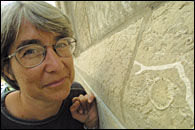 Redpath Museum curator Ingrid Birker with a Carboniferous crinoids.
Redpath Museum curator Ingrid Birker with a Carboniferous crinoids.PHOTO: Owen Egan |
|
Rosy-cheeked frosh got you feeling ancient? To gain some perspective on aging, look no further than the humble prehistoric cephalopod. According to a recent booklet published by the Redpath Museum, downtown Montreal is chockablock with such paleozoic holdovers -- the trick is knowing where to look.
Ingrid Birker, curator of the Redpath's invertebrate fossil collection, explains that what began as "a whimsical personal project" eventually became What Building Stones Tell: A Walking Tour Focussing on the Fossils, Rocks and Minerals of Montreal Buildings. Upon moving to Montreal from Toronto in 1981, Birker became intrigued by the "huge diversity of building materials which you don't find further inland." Of particular interest was the abundance of Quebec limestone -- a.k.a. the fermented mineralized sediment that accumulated at the bottom of the deep, inland tropical sea once covering the area. To make a 500-million-year story short: dead sea creatures sank into the sediment; the corpse-filled sediment became fossil-encrusted limestone; and the limestone became some of Montreal's most striking buildings, (give or take a few steps). In other words: Holt Renfrew is lousy with Carboniferous crinoids.
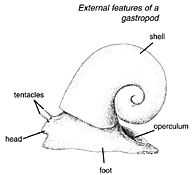 External features of a gastropod
External features of a gastropod |
|
Birker began giving impromptu tours of these urban treasures to friends, later compiling an informal list for curious Redpath visitors. Now this information is available to all in a convenient 31-page package. Working with funding from the Étalez votre science program (Ministère de la Culture et des Communications), Birker and co-author/colleague Joan Kaylor chose 14 stone buildings located on or around Sherbrooke Street, all notable for their paleontologic and/or geologic peculiarities.
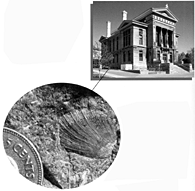 Shell on the Redpath Museum
Shell on the Redpath Museum |
|
The booklet starts with the Redpath Museum itself: the tiny white smudges in the west side of the limestone foundation are, in fact, fossilized Rafinesquina alternata (brachiopod) shells dating back 470 million years. As with most of the examples described in the booklet, the fossils aren't readily apparent: contractors routinely hid such "flaws" in out-of-the-way locations, so as not to sully a building's magnificence.
The Redpath shells are but the beginning. At the Mount Royal Club on Sherbrooke, the strange spiral squiggles are actually remnants of gastropods from the Devonian Period (363-409 million years ago).
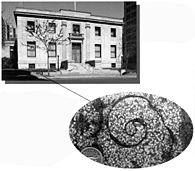 Gastropod molds on the Mount Royal Club
Gastropod molds on the Mount Royal Club |
|
The wee circles on the exterior of Holt Renfrew turn out to be cross-sections of crinoid segmented columns from the Carboniferous Period (290-363 million years ago).
At the castle-like Le Château Apartments, what appear to be tiny tire tracks are really worm burrows from the Ordovician Period (439-510 million years ago).
At the McGill Faculty Club, what look like cat paw-prints embedded in the red brick are, well, cat paw-prints from the 1870s: stray cats routinely raced across the exposed molds before the bricks were fired, unwittingly leaving their mark on history.
Birker isn't alone in her enthusiasm for such oddities. A group of local architects, builders and designers (calling themselves "The Cat Paw Club," naturally) obsessively prowls the city looking for similar feline-inflicted anomalies. On a less shadowy note, public response to What Building Stones Tell has been positive to the point that Birker even received hot geological gossip from the granddaughter of one of the building's architects. (It turns out the reason the Le Château Apartments boast fancy, expensive Manitoba limestone -- usually reserved for highfaluting projects like the Houses of Parliament -- was because the architect had a family connection to the quarry.) Birker hasn't ruled out a sequel (she says there's easily enough material), and a French translation of the current volume is already planned for next summer.
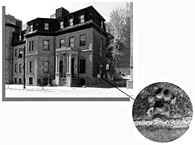 Cat paw-print on the McGill Faculty Club
Cat paw-print on the McGill Faculty Club |
|
"I like the idea that what makes something like the Le Château pleasing to our eyes now," raves Birker, "is worm burrows! The builders deliberately hid these 'flaws' because they didn't think they were worth displaying -- but it doesn't matter, because we still found them.
"Lowly worm burrows used to build castles! There's something kinky about that."
What Building Stones Tell is available for $5 from the Redpath Museum, McGill Bookstore, Heritage Montreal, the Canadian Centre for Architecture, and the Fine Arts bookstore. A free, English-language guided walking tour of Sherbrooke St., based on the booklet, is scheduled for Sunday, October 27 at 2 pm. RSVP Ingrid Birker at 398-4086, ext. 4094.

